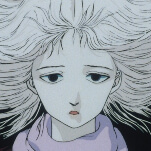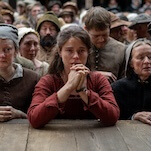The phrase
"style over substance" generally denotes empty flash, but it takes on a
slightly different meaning in Blindness, an adaptation of Jóse Saramago's acclaimed
allegorical novel about a mass epidemic of sightlessness. Here, style and
substance are both ample. They're just at odds with one another, as director
Fernando Meirelles piles on a host of visual gimmicks, no doubt intending to
suggest the intense disorientation of those newly inflected with "white
blindness." But the effect of his aggressive language—the extremely
shallow focus, the heavenly whites and blurry blacks, the jagged editorial
ellipses—are a major distraction from what might have been a timely and
politically loaded tale of society on the brink. There's a good movie here, but
we get it in pieces that are sometimes hard to decipher.
The opening
scenes neatly capture the spread of the mysterious disease: In a traffic jam in
an unnamed city, a man suddenly loses his sight. A good Samaritan helps escort
him home, but then he goes blind, too. As does the man's wife and then his
optometrist, played by Mark Ruffalo, and also some of the patients in his
waiting room. Faced with this extraordinary outbreak, the government rounds up
the first wave of victims and puts them in quarantine in an abandoned hospital.
Among the inmates is Ruffalo's wife Julianne Moore, who hides the fact that she
can see in order to stay close to her husband. With the unaffected naturally
keeping their distance and guards with itchy trigger-fingers penning them in,
the blind are left leading the blind, and the situation rapidly deteriorates
into a Lord Of The Flies-like scenario.
In order
for Blindness to
work, this big unraveling needs to be revealed with inexorable logic, as a
mini-society of ordinary, decent people are broken down into
savages—violent, lusty, and territorial. And that's where Meirelles'
distracting flourishes do the most damage, because it's never clear enough how
one step down the ladder leads naturally to another. It's questionable whether
Meirelles even needed to illustrate "white blindness" visually—though a
similar ploy worked for The Diving Bell And The Butterfly—but the style acts like a
screen between the audience and the movie that's difficult to circumvent. In
that sense, maybe Meirelles gets the blind person's experience right after all.









































